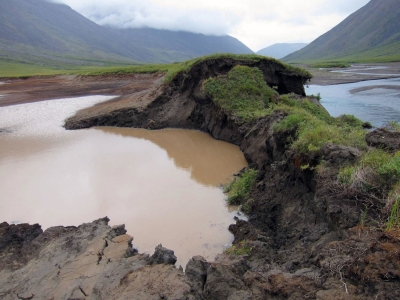
When we talk about greenhouse gases, we often think of carbon dioxide (CO2). But did you know nitrous oxide (N2O), also called laughing gas, is a potent greenhouse gas, with ozone-depleting property? And scientists have recently found a new source of N20 emission in the Siberian permafrost.
This emission comes from Yedoma, a type of Pleistocene-age (formed 1.8 million to 10,000 years before present) permafrost that contains a significant amount of organic material. It stretches over more than a million sq km of land in the Northern Hemisphere.
Scientists have known that as permafrost thaws, it releases a significant amount of methane. Now researchers have found that this stretch of permafrost also releases between 10 and 100 times the amount of nitrous oxide that would typically be expected from permafrost thaw. Nitrous oxide is produced by microbes in the soil. As the permafrost thaws, the N20-producing microbe population grows while the N20-consuming microbe population shrinks. That changes the nitrogen cycle and means significantly more nitrous oxide is getting pushed out.
Why is N20 a cause for concern?
Like other greenhouse gases, nitrous oxide absorbs radiation and traps heat in the atmosphere. N20 has a long lifespan in the atmosphere – about 114 years.
- N20 is nearly 300 times more potent at warming the planet than carbon dioxide, which means that even small sources of emissions can have a significant impact on the climate.
- N2O has emerged as the most critical ozone-depleting substance. It is stable in the lowest level of the atmosphere, the troposphere and acts like a greenhouse gas. When it migrates up to the stratosphere, it reacts with ozone and depletes it.
- A 2020 review of nitrous oxide sources and sinks found that emissions rose 30% in the last four decades. Nitrous oxide is responsible for roughly 7% of global warming since preindustrial times.
What are the other sources of N20?
- Nitrous oxide in the atmosphere comes from both natural and anthropogenic sources. The largest source of nitrous oxide is agriculture (73%), and the majority of agricultural emissions result from usage of nitrogen fertilizers and ill-management of animals waste.
The growing demand for food and feed for animals and increased usage of fertilizers will further increase global nitrous oxide emissions. Most N20 emissions have come from emerging countries like India, China and Brazil
- Fossil fuel combustion and industrial processes are the other important source of nitrous oxide emissions. Biomass burning atmospheric deposition and wastewater treatment are the other sources.
Picture Credit : Google



